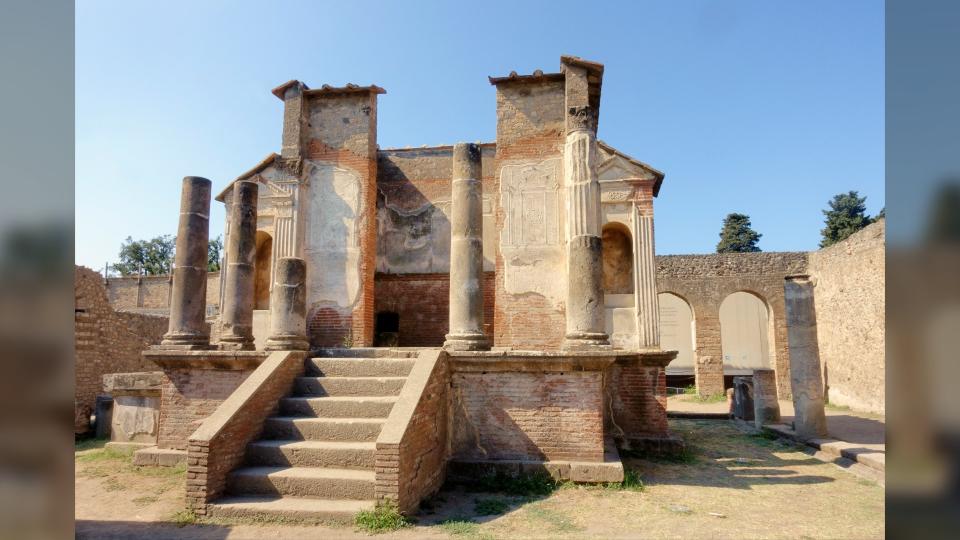Ancient Romans sacrificed birds to the goddess Isis, burnt bones in Pompeii reveal

Archaeologists excavating the Temple of Isis in Pompeii have discovered the remains of a ritual banquet where dozens of birds were eaten, possibly to placate the goddess after her temple was downsized.
The find shows the importance of birds to worshippers of Isis, an Egyptian cult that had become established in Roman society by the first century A.D., according to a study published April 27 in the International Journal of Osteoarchaeology.
"The ritual … was likely performed by three priests of Isis in a single day," possibly to atone for renovations that had made the temple slightly smaller, study first author Chiara Corbino, an archaeologist at Italy's Institute of Heritage Science, told Live Science in an email.
Pompeii was a wealthy Roman resort city that was destroyed when Mount Vesuvius erupted in A.D. 79. It was buried beneath a layer of volcanic ash up to 20 feet (6 meters) thick and has been progressively excavated to provide a snapshot of life in the early Roman Empire.
Corbino said the renovations seem to have been made after an earthquake damaged the temple in A.D. 62, which meant the banquet took place between that time and the eruption in 79.
Related: Ancient mummy portraits and rare Isis-Aphrodite idol discovered in Egypt

The excavations revealed the charred remains of at least eight chickens, a goose, a turtle dove, a pig and two clams; part of the meat would be cooked and eaten by the priests, while the rest would have been set out on the floor as an offering to Isis, she said.
Isis — the Greek name for the "great mother" of the ancient Egyptians, known as Aset or Eset — was often portrayed with bird wings, and some archaeologists think she may have once been a bird deity, like the falcon-headed Egyptian god Horus.
The new finding adds more evidence that birds were central to the Isis cult. "This work confirms that bird sacrifice was an important part of the Isis rituals," the authors wrote in the study.
Cult of Isis
The Isis cult spread from Egypt to Greece and became part of the Roman world by the first century B.C.
Sabine Deschler-Erb, a historian and archaeologist at the University of Basel in Switzerland who was not involved in the study, said the mobility of soldiers, administrators and traders in the Roman Empire promoted the spread of Eastern religions such as the Isis cult.
The cult rituals were secret and not allowed to be written down, so archaeology is the only way of finding out about them, she said. Until now, in the case of the Isis cult, sacrificial remains had been found only in Greece, Spain and Germany.
"The study of Pompeii is the first archaeozoological investigation of an Isis sanctuary in Italy," she said.

Animal sacrifices
Isabel Köster, a historian at the University of Colorado Boulder who didn't take part in the study, noted that the finds at Pompeii are similar to the remains of bird sacrifices found at Isis temples in Roman territories, such as the Sanctuary of Isis and Magna Mater in Mainz, Germany.
However, Jan Bremmer, a historian and professor emeritus at the University of Groningen in the Netherlands who wasn't involved in the study, said the chickens and geese offered at Pompeii suggest Isis was not an important god in Roman worship at the time. "Those usually received more important animals," like cattle, he said.
related stories
—Sacred chickens, witches and animal entrails: 7 unusual ancient Roman superstitions
—Ancient sanctuary used by Roman soldiers nearly 2,000 years ago found in the Netherlands
—The real way ancient priests sacrificed animals at the Roman 'gate to hell'
Regardless of their species, sacrificial animals would usually be ceremonially killed while appropriate prayers were recited or sung. The meat was often then charred, and part of it was offered to the god; the rest would typically be cooked and eaten by the priests and whoever had paid for the sacrifice.
Erica Rowan, an archaeologist at Royal Holloway, University of London who wasn't involved with the study, noted both similarities and differences between the bird offerings at Pompeii and those made to Isis elsewhere. For example, the animal sacrifices to Isis at Mainz and at Delos in Greece were almost completely consumed by fire, rather than leaving significant remains; while the remains of cattle and fish were found with those of birds at the Baelo Claudia site in Spain.
"They are similar enough to show that there was clearly communication between the various congregations or cult members," she said.


